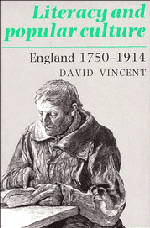Summary
Until the introduction of the Revised Code in 1863, the task of signing the marriage register was the only examination the great majority of the population would ever face. Those who signed displayed both their identity and their independence; those who did not remained anonymous until the register was completed by another hand. As with most examinations, success might be qualified, but failure was absolute. A signature said little about educational standards. Only the gentry and the occasional lawyer drew attention to their learning by the elaboration of their writing; few adopted the twentieth-century conceit of cultivated illegibility. A mark, on the other hand, was evidence of undivided ignorance. To contemporary observers, the tables which the Registrar General began to compile in 1839 split England in two. In every county, and later in every registration district, a precise calculation could be made of the proportion of the population which lay outside the boundary of civilised society. The figures defined the problem and over time displayed its solution. By 1914 England could claim a homogeneous culture.
Yet even at the time, those responsible for compiling the statistics recognised the danger of over-simplification. It was not just that the returns of the individual registration districts revealed an immense range of standards within and between different parts of the country.
- Type
- Chapter
- Information
- Literacy and Popular CultureEngland 1750–1914, pp. 21 - 52Publisher: Cambridge University PressPrint publication year: 1989



